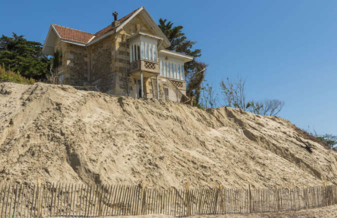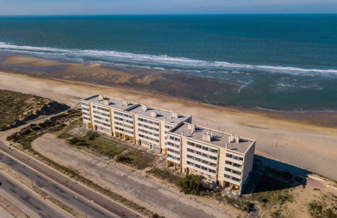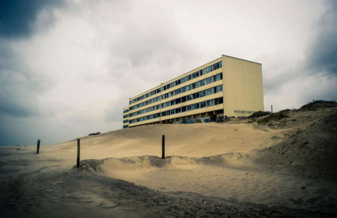 Soulac-sur-Mer is a coastal town in the Gironde region of southwest France, known for its natural and historical attractions. The town is a popular tourist destination for those who enjoy the beaches of the Atlantic Ocean. Located near the Garonne River Delta and the Atlantic coastline, the history of Soulac-sur-Mer dates back to the Middle Ages. It became especially well-known in the 19th century with the growth of the tourism industry, turning into a popular summer destination for families. Throughout history, the area has witnessed the construction of various structures, including luxurious villas, summer homes, and buildings related to fishing and maritime industries.
Soulac-sur-Mer is a coastal town in the Gironde region of southwest France, known for its natural and historical attractions. The town is a popular tourist destination for those who enjoy the beaches of the Atlantic Ocean. Located near the Garonne River Delta and the Atlantic coastline, the history of Soulac-sur-Mer dates back to the Middle Ages. It became especially well-known in the 19th century with the growth of the tourism industry, turning into a popular summer destination for families. Throughout history, the area has witnessed the construction of various structures, including luxurious villas, summer homes, and buildings related to fishing and maritime industries.
 The architecture of Soulac-sur-Mer is influenced by several historical periods, and various buildings from different eras can be seen in the town:
The architecture of Soulac-sur-Mer is influenced by several historical periods, and various buildings from different eras can be seen in the town:
- 19th-Century Villas: Many coastal houses and villas in the region date back to the 19th century, designed in classical and neoclassical architectural styles. These villas often feature large windows and balconies overlooking the sea.
- Historic Soulac Church: One of the important buildings in the area is the Notre-Dame-de-la-Fin-des-Terres Church, dating back to the Middle Ages. This Romanesque-style church symbolizes the town's spirituality and history.
- Storm-Resistant Buildings: Given the town's coastal location, some structures, especially coastal buildings and fishing properties, are designed to withstand strong winds and marine storms.
- Coastal and Residential Buildings: The design of these buildings uses moisture-resistant materials and considers factors such as proper ventilation and durability against humid weather.
Structural Challenges and Engineering Issues
Due to its coastal location and exposure to severe climatic impacts, Soulac-sur-Mer faces specific challenges:
- Coastal Erosion: One of the biggest challenges for Soulac-sur-Mer is coastal erosion, which poses a serious threat to coastal structures and homes near the sea. Rising sea levels and severe storms can lead to land and infrastructure degradation.
- Storms and Flooding: The town is prone to marine storms and floods, which can damage structures and main roads. This requires weather-resistant designs and the construction of proper water drainage systems.
- Moisture and Material Erosion: High humidity and frequent rainfall can cause rapid erosion of building materials such as wood and brick. Regular maintenance and restoration of structures are necessary.
Engineering Efforts and Actions to Mitigate Environmental and Structural Damage
Efforts have been made in Soulac-sur-Mer to reduce environmental damage and protect structures from climatic impacts:
- Use of Moisture-Resistant Materials: In construction and repairs, materials resistant to moisture and corrosion, such as salt-resistant concrete and waterproof bricks, are used.
- Protective Walls and Barriers: To combat threats from storms and floods, some coastal areas are reinforced with protective walls and small barriers.
- Coastal Restoration Projects: Projects aimed at restoring the coastline and preventing further erosion have been initiated. These projects include using rivers and native plants to stabilize sand and soil.
- Installation of Drainage Systems: Proper drainage systems have been installed on the beaches and critical areas to prevent flooding.
Proposed Solutions for Sustainable Development and Further Reinforcement
 To address future challenges and further reinforce the town, the following measures are proposed:
To address future challenges and further reinforce the town, the following measures are proposed:
- Climate-Resilient Design: Given the effects of climate change, it is essential to incorporate modern technologies, such as waterproof coatings and storm-resistant materials, in structural designs.
- Development of Renewable Energy: To reduce reliance on non-renewable energy sources, solar panels and wind turbines can be used to supply power to various parts of the town.
- Environmental Conservation: Given the coastal location, preserving and enhancing local ecosystems, such as coastal areas and lakes, can increase regional sustainability.
- Public Education and Awareness: Raising public awareness about the importance of environmental conservation and how to combat climate change can encourage active community participation.
With its long history as a coastal tourist destination, Soulac-sur-Mer has always paid special attention to the sustainability of its structures and infrastructure. The town faces serious challenges such as coastal erosion, floods, and storms. However, engineering efforts, including the use of resistant materials, coastal restoration projects, and protective walls, have helped preserve the structures and enhance the area's sustainability. In the future, greater emphasis on using modern technologies, renewable energy, and environmental conservation can contribute to the sustainable development of this region.




















